Health Promotion in Diabetic Patients
VerifiedAdded on 2023/06/12
|8
|2403
|272
AI Summary
This study tends to demonstrate how a nurse can apply the five strategies from Ottawa charter to promote health promotion for diabetes. The five strategies include creating a supportive environment, developing personal skills, strengthening community actions, building public health policies and reorienting health services. Nurses use these strategies to educate the public using strategic suitable skills in order to make improvements of peoples health. Read more on Desklib.
Contribute Materials
Your contribution can guide someone’s learning journey. Share your
documents today.
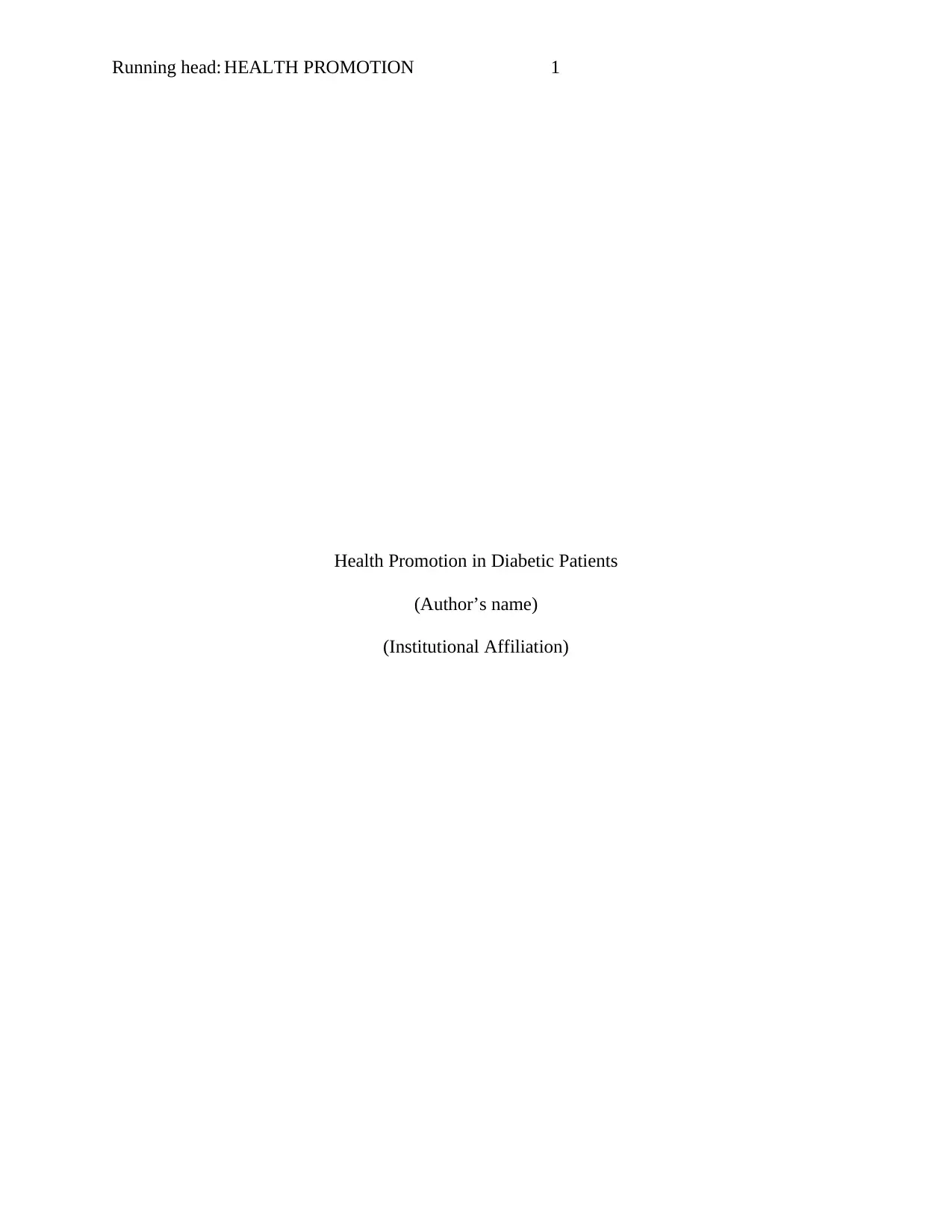
Running head: HEALTH PROMOTION 1
Health Promotion in Diabetic Patients
(Author’s name)
(Institutional Affiliation)
Health Promotion in Diabetic Patients
(Author’s name)
(Institutional Affiliation)
Secure Best Marks with AI Grader
Need help grading? Try our AI Grader for instant feedback on your assignments.
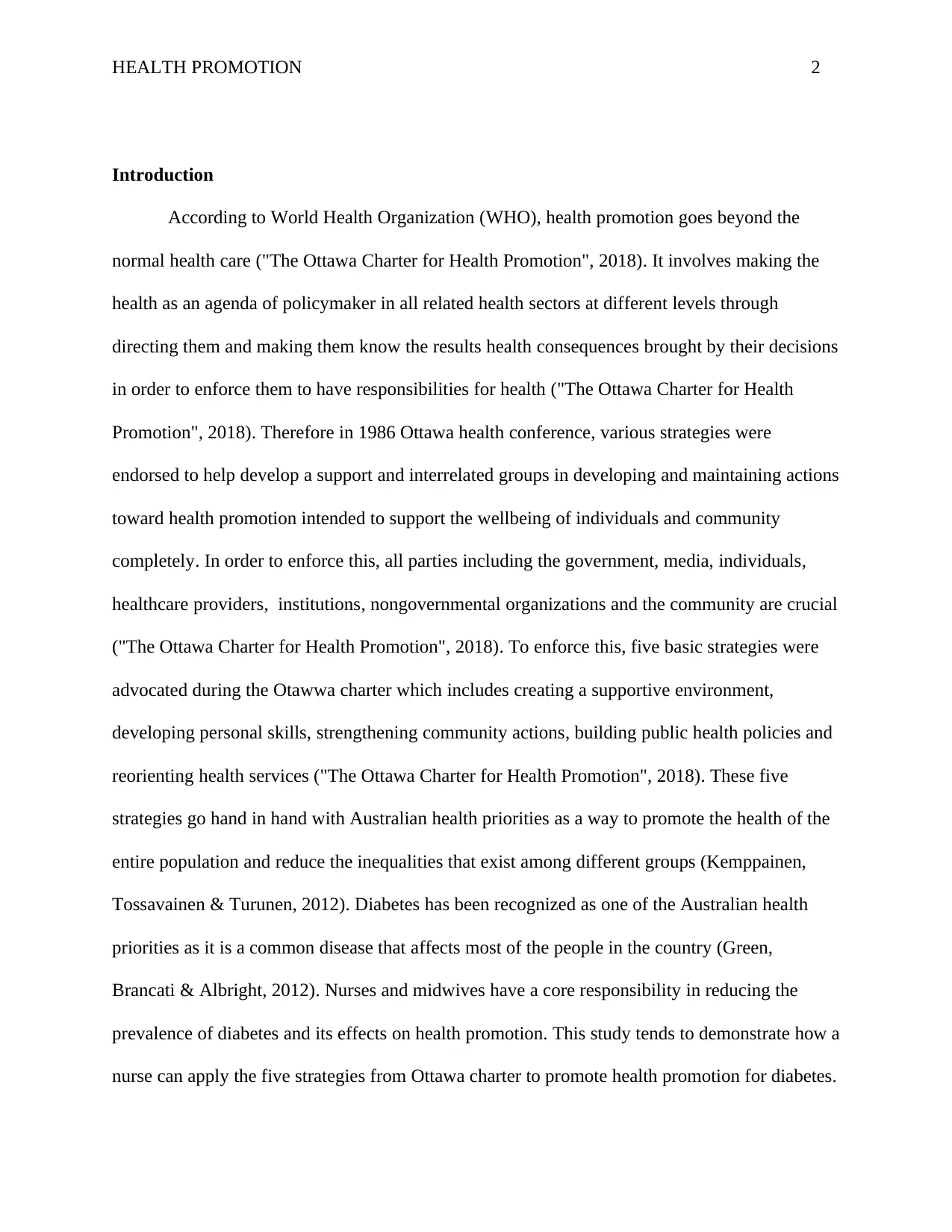
HEALTH PROMOTION 2
Introduction
According to World Health Organization (WHO), health promotion goes beyond the
normal health care ("The Ottawa Charter for Health Promotion", 2018). It involves making the
health as an agenda of policymaker in all related health sectors at different levels through
directing them and making them know the results health consequences brought by their decisions
in order to enforce them to have responsibilities for health ("The Ottawa Charter for Health
Promotion", 2018). Therefore in 1986 Ottawa health conference, various strategies were
endorsed to help develop a support and interrelated groups in developing and maintaining actions
toward health promotion intended to support the wellbeing of individuals and community
completely. In order to enforce this, all parties including the government, media, individuals,
healthcare providers, institutions, nongovernmental organizations and the community are crucial
("The Ottawa Charter for Health Promotion", 2018). To enforce this, five basic strategies were
advocated during the Otawwa charter which includes creating a supportive environment,
developing personal skills, strengthening community actions, building public health policies and
reorienting health services ("The Ottawa Charter for Health Promotion", 2018). These five
strategies go hand in hand with Australian health priorities as a way to promote the health of the
entire population and reduce the inequalities that exist among different groups (Kemppainen,
Tossavainen & Turunen, 2012). Diabetes has been recognized as one of the Australian health
priorities as it is a common disease that affects most of the people in the country (Green,
Brancati & Albright, 2012). Nurses and midwives have a core responsibility in reducing the
prevalence of diabetes and its effects on health promotion. This study tends to demonstrate how a
nurse can apply the five strategies from Ottawa charter to promote health promotion for diabetes.
Introduction
According to World Health Organization (WHO), health promotion goes beyond the
normal health care ("The Ottawa Charter for Health Promotion", 2018). It involves making the
health as an agenda of policymaker in all related health sectors at different levels through
directing them and making them know the results health consequences brought by their decisions
in order to enforce them to have responsibilities for health ("The Ottawa Charter for Health
Promotion", 2018). Therefore in 1986 Ottawa health conference, various strategies were
endorsed to help develop a support and interrelated groups in developing and maintaining actions
toward health promotion intended to support the wellbeing of individuals and community
completely. In order to enforce this, all parties including the government, media, individuals,
healthcare providers, institutions, nongovernmental organizations and the community are crucial
("The Ottawa Charter for Health Promotion", 2018). To enforce this, five basic strategies were
advocated during the Otawwa charter which includes creating a supportive environment,
developing personal skills, strengthening community actions, building public health policies and
reorienting health services ("The Ottawa Charter for Health Promotion", 2018). These five
strategies go hand in hand with Australian health priorities as a way to promote the health of the
entire population and reduce the inequalities that exist among different groups (Kemppainen,
Tossavainen & Turunen, 2012). Diabetes has been recognized as one of the Australian health
priorities as it is a common disease that affects most of the people in the country (Green,
Brancati & Albright, 2012). Nurses and midwives have a core responsibility in reducing the
prevalence of diabetes and its effects on health promotion. This study tends to demonstrate how a
nurse can apply the five strategies from Ottawa charter to promote health promotion for diabetes.
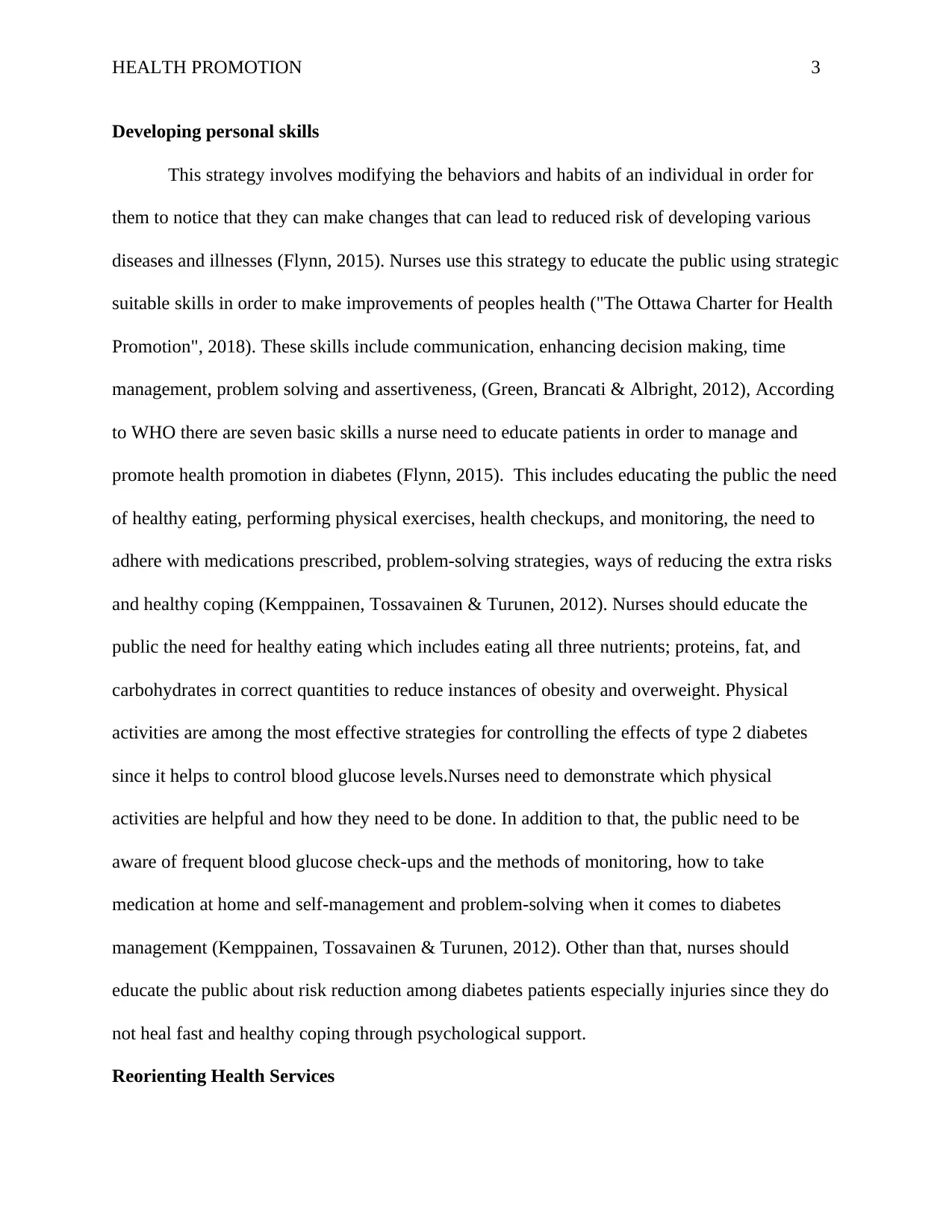
HEALTH PROMOTION 3
Developing personal skills
This strategy involves modifying the behaviors and habits of an individual in order for
them to notice that they can make changes that can lead to reduced risk of developing various
diseases and illnesses (Flynn, 2015). Nurses use this strategy to educate the public using strategic
suitable skills in order to make improvements of peoples health ("The Ottawa Charter for Health
Promotion", 2018). These skills include communication, enhancing decision making, time
management, problem solving and assertiveness, (Green, Brancati & Albright, 2012), According
to WHO there are seven basic skills a nurse need to educate patients in order to manage and
promote health promotion in diabetes (Flynn, 2015). This includes educating the public the need
of healthy eating, performing physical exercises, health checkups, and monitoring, the need to
adhere with medications prescribed, problem-solving strategies, ways of reducing the extra risks
and healthy coping (Kemppainen, Tossavainen & Turunen, 2012). Nurses should educate the
public the need for healthy eating which includes eating all three nutrients; proteins, fat, and
carbohydrates in correct quantities to reduce instances of obesity and overweight. Physical
activities are among the most effective strategies for controlling the effects of type 2 diabetes
since it helps to control blood glucose levels.Nurses need to demonstrate which physical
activities are helpful and how they need to be done. In addition to that, the public need to be
aware of frequent blood glucose check-ups and the methods of monitoring, how to take
medication at home and self-management and problem-solving when it comes to diabetes
management (Kemppainen, Tossavainen & Turunen, 2012). Other than that, nurses should
educate the public about risk reduction among diabetes patients especially injuries since they do
not heal fast and healthy coping through psychological support.
Reorienting Health Services
Developing personal skills
This strategy involves modifying the behaviors and habits of an individual in order for
them to notice that they can make changes that can lead to reduced risk of developing various
diseases and illnesses (Flynn, 2015). Nurses use this strategy to educate the public using strategic
suitable skills in order to make improvements of peoples health ("The Ottawa Charter for Health
Promotion", 2018). These skills include communication, enhancing decision making, time
management, problem solving and assertiveness, (Green, Brancati & Albright, 2012), According
to WHO there are seven basic skills a nurse need to educate patients in order to manage and
promote health promotion in diabetes (Flynn, 2015). This includes educating the public the need
of healthy eating, performing physical exercises, health checkups, and monitoring, the need to
adhere with medications prescribed, problem-solving strategies, ways of reducing the extra risks
and healthy coping (Kemppainen, Tossavainen & Turunen, 2012). Nurses should educate the
public the need for healthy eating which includes eating all three nutrients; proteins, fat, and
carbohydrates in correct quantities to reduce instances of obesity and overweight. Physical
activities are among the most effective strategies for controlling the effects of type 2 diabetes
since it helps to control blood glucose levels.Nurses need to demonstrate which physical
activities are helpful and how they need to be done. In addition to that, the public need to be
aware of frequent blood glucose check-ups and the methods of monitoring, how to take
medication at home and self-management and problem-solving when it comes to diabetes
management (Kemppainen, Tossavainen & Turunen, 2012). Other than that, nurses should
educate the public about risk reduction among diabetes patients especially injuries since they do
not heal fast and healthy coping through psychological support.
Reorienting Health Services
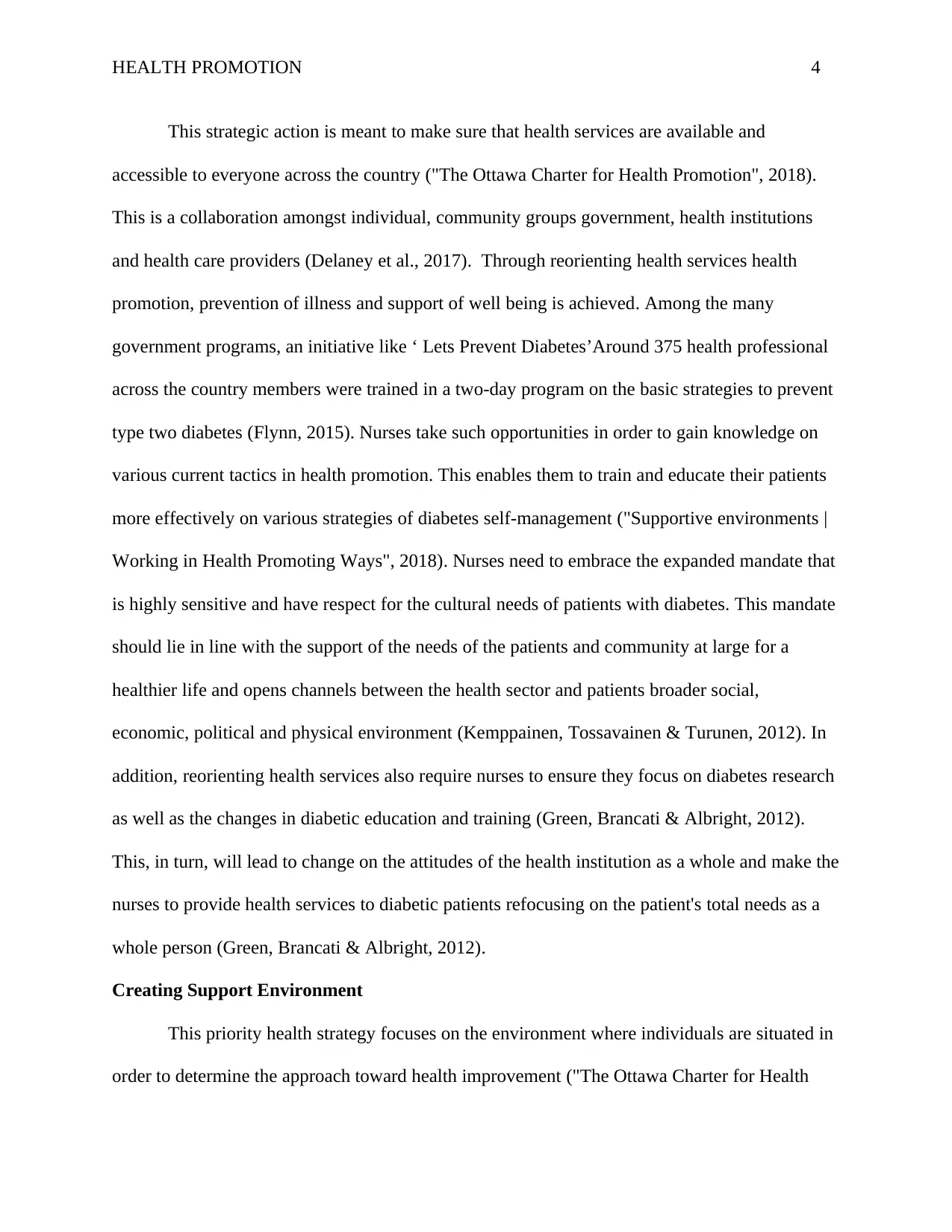
HEALTH PROMOTION 4
This strategic action is meant to make sure that health services are available and
accessible to everyone across the country ("The Ottawa Charter for Health Promotion", 2018).
This is a collaboration amongst individual, community groups government, health institutions
and health care providers (Delaney et al., 2017). Through reorienting health services health
promotion, prevention of illness and support of well being is achieved. Among the many
government programs, an initiative like ‘ Lets Prevent Diabetes’Around 375 health professional
across the country members were trained in a two-day program on the basic strategies to prevent
type two diabetes (Flynn, 2015). Nurses take such opportunities in order to gain knowledge on
various current tactics in health promotion. This enables them to train and educate their patients
more effectively on various strategies of diabetes self-management ("Supportive environments |
Working in Health Promoting Ways", 2018). Nurses need to embrace the expanded mandate that
is highly sensitive and have respect for the cultural needs of patients with diabetes. This mandate
should lie in line with the support of the needs of the patients and community at large for a
healthier life and opens channels between the health sector and patients broader social,
economic, political and physical environment (Kemppainen, Tossavainen & Turunen, 2012). In
addition, reorienting health services also require nurses to ensure they focus on diabetes research
as well as the changes in diabetic education and training (Green, Brancati & Albright, 2012).
This, in turn, will lead to change on the attitudes of the health institution as a whole and make the
nurses to provide health services to diabetic patients refocusing on the patient's total needs as a
whole person (Green, Brancati & Albright, 2012).
Creating Support Environment
This priority health strategy focuses on the environment where individuals are situated in
order to determine the approach toward health improvement ("The Ottawa Charter for Health
This strategic action is meant to make sure that health services are available and
accessible to everyone across the country ("The Ottawa Charter for Health Promotion", 2018).
This is a collaboration amongst individual, community groups government, health institutions
and health care providers (Delaney et al., 2017). Through reorienting health services health
promotion, prevention of illness and support of well being is achieved. Among the many
government programs, an initiative like ‘ Lets Prevent Diabetes’Around 375 health professional
across the country members were trained in a two-day program on the basic strategies to prevent
type two diabetes (Flynn, 2015). Nurses take such opportunities in order to gain knowledge on
various current tactics in health promotion. This enables them to train and educate their patients
more effectively on various strategies of diabetes self-management ("Supportive environments |
Working in Health Promoting Ways", 2018). Nurses need to embrace the expanded mandate that
is highly sensitive and have respect for the cultural needs of patients with diabetes. This mandate
should lie in line with the support of the needs of the patients and community at large for a
healthier life and opens channels between the health sector and patients broader social,
economic, political and physical environment (Kemppainen, Tossavainen & Turunen, 2012). In
addition, reorienting health services also require nurses to ensure they focus on diabetes research
as well as the changes in diabetic education and training (Green, Brancati & Albright, 2012).
This, in turn, will lead to change on the attitudes of the health institution as a whole and make the
nurses to provide health services to diabetic patients refocusing on the patient's total needs as a
whole person (Green, Brancati & Albright, 2012).
Creating Support Environment
This priority health strategy focuses on the environment where individuals are situated in
order to determine the approach toward health improvement ("The Ottawa Charter for Health
Secure Best Marks with AI Grader
Need help grading? Try our AI Grader for instant feedback on your assignments.
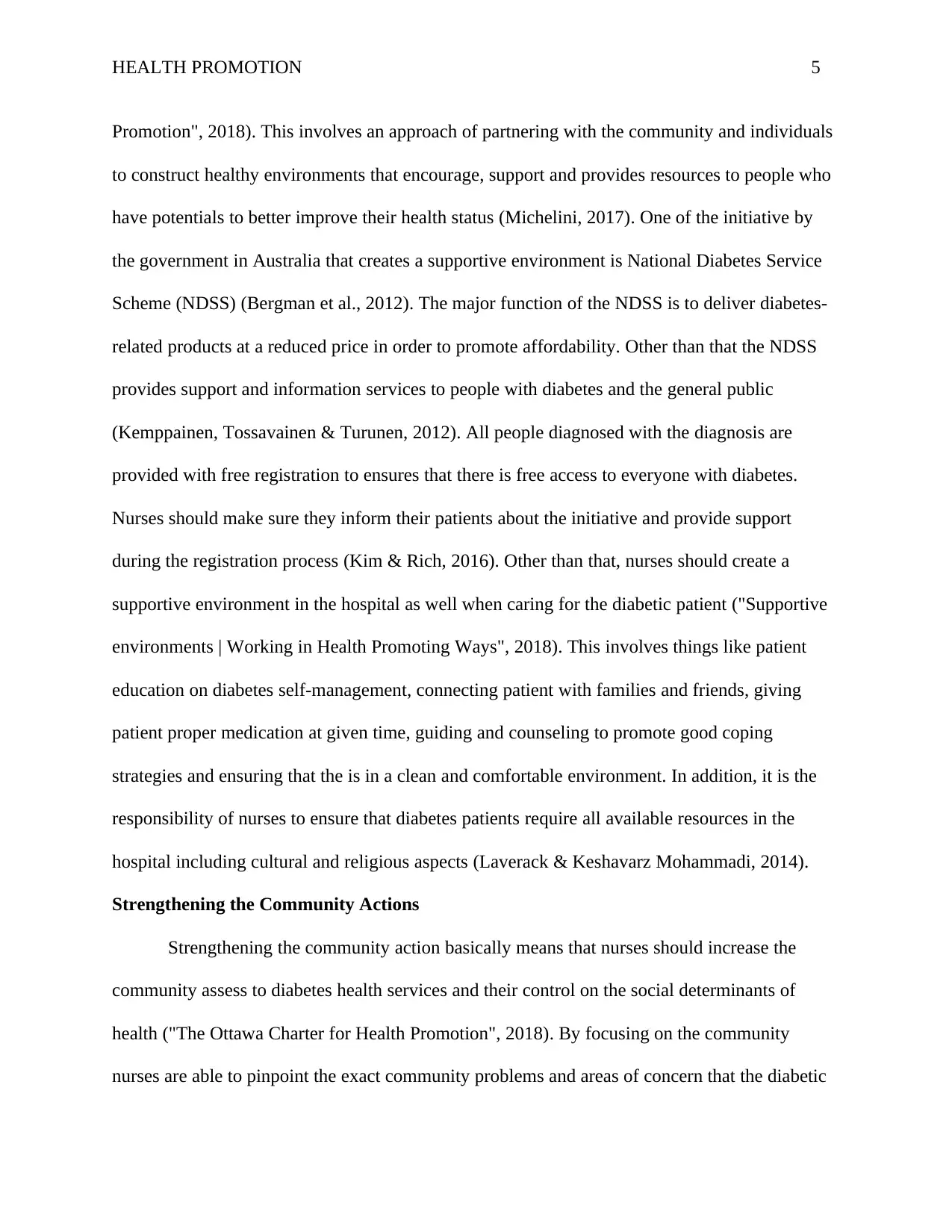
HEALTH PROMOTION 5
Promotion", 2018). This involves an approach of partnering with the community and individuals
to construct healthy environments that encourage, support and provides resources to people who
have potentials to better improve their health status (Michelini, 2017). One of the initiative by
the government in Australia that creates a supportive environment is National Diabetes Service
Scheme (NDSS) (Bergman et al., 2012). The major function of the NDSS is to deliver diabetes-
related products at a reduced price in order to promote affordability. Other than that the NDSS
provides support and information services to people with diabetes and the general public
(Kemppainen, Tossavainen & Turunen, 2012). All people diagnosed with the diagnosis are
provided with free registration to ensures that there is free access to everyone with diabetes.
Nurses should make sure they inform their patients about the initiative and provide support
during the registration process (Kim & Rich, 2016). Other than that, nurses should create a
supportive environment in the hospital as well when caring for the diabetic patient ("Supportive
environments | Working in Health Promoting Ways", 2018). This involves things like patient
education on diabetes self-management, connecting patient with families and friends, giving
patient proper medication at given time, guiding and counseling to promote good coping
strategies and ensuring that the is in a clean and comfortable environment. In addition, it is the
responsibility of nurses to ensure that diabetes patients require all available resources in the
hospital including cultural and religious aspects (Laverack & Keshavarz Mohammadi, 2014).
Strengthening the Community Actions
Strengthening the community action basically means that nurses should increase the
community assess to diabetes health services and their control on the social determinants of
health ("The Ottawa Charter for Health Promotion", 2018). By focusing on the community
nurses are able to pinpoint the exact community problems and areas of concern that the diabetic
Promotion", 2018). This involves an approach of partnering with the community and individuals
to construct healthy environments that encourage, support and provides resources to people who
have potentials to better improve their health status (Michelini, 2017). One of the initiative by
the government in Australia that creates a supportive environment is National Diabetes Service
Scheme (NDSS) (Bergman et al., 2012). The major function of the NDSS is to deliver diabetes-
related products at a reduced price in order to promote affordability. Other than that the NDSS
provides support and information services to people with diabetes and the general public
(Kemppainen, Tossavainen & Turunen, 2012). All people diagnosed with the diagnosis are
provided with free registration to ensures that there is free access to everyone with diabetes.
Nurses should make sure they inform their patients about the initiative and provide support
during the registration process (Kim & Rich, 2016). Other than that, nurses should create a
supportive environment in the hospital as well when caring for the diabetic patient ("Supportive
environments | Working in Health Promoting Ways", 2018). This involves things like patient
education on diabetes self-management, connecting patient with families and friends, giving
patient proper medication at given time, guiding and counseling to promote good coping
strategies and ensuring that the is in a clean and comfortable environment. In addition, it is the
responsibility of nurses to ensure that diabetes patients require all available resources in the
hospital including cultural and religious aspects (Laverack & Keshavarz Mohammadi, 2014).
Strengthening the Community Actions
Strengthening the community action basically means that nurses should increase the
community assess to diabetes health services and their control on the social determinants of
health ("The Ottawa Charter for Health Promotion", 2018). By focusing on the community
nurses are able to pinpoint the exact community problems and areas of concern that the diabetic
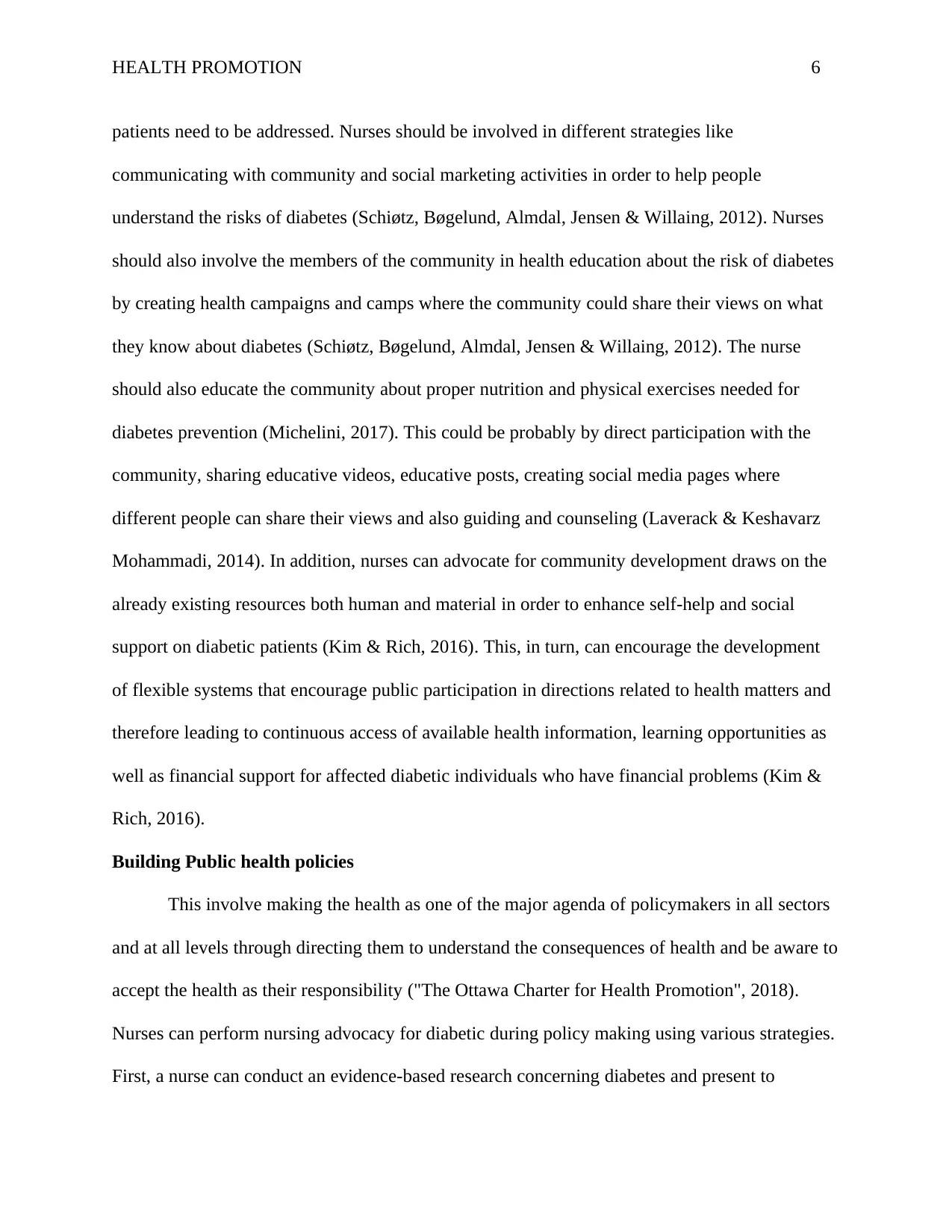
HEALTH PROMOTION 6
patients need to be addressed. Nurses should be involved in different strategies like
communicating with community and social marketing activities in order to help people
understand the risks of diabetes (Schiøtz, Bøgelund, Almdal, Jensen & Willaing, 2012). Nurses
should also involve the members of the community in health education about the risk of diabetes
by creating health campaigns and camps where the community could share their views on what
they know about diabetes (Schiøtz, Bøgelund, Almdal, Jensen & Willaing, 2012). The nurse
should also educate the community about proper nutrition and physical exercises needed for
diabetes prevention (Michelini, 2017). This could be probably by direct participation with the
community, sharing educative videos, educative posts, creating social media pages where
different people can share their views and also guiding and counseling (Laverack & Keshavarz
Mohammadi, 2014). In addition, nurses can advocate for community development draws on the
already existing resources both human and material in order to enhance self-help and social
support on diabetic patients (Kim & Rich, 2016). This, in turn, can encourage the development
of flexible systems that encourage public participation in directions related to health matters and
therefore leading to continuous access of available health information, learning opportunities as
well as financial support for affected diabetic individuals who have financial problems (Kim &
Rich, 2016).
Building Public health policies
This involve making the health as one of the major agenda of policymakers in all sectors
and at all levels through directing them to understand the consequences of health and be aware to
accept the health as their responsibility ("The Ottawa Charter for Health Promotion", 2018).
Nurses can perform nursing advocacy for diabetic during policy making using various strategies.
First, a nurse can conduct an evidence-based research concerning diabetes and present to
patients need to be addressed. Nurses should be involved in different strategies like
communicating with community and social marketing activities in order to help people
understand the risks of diabetes (Schiøtz, Bøgelund, Almdal, Jensen & Willaing, 2012). Nurses
should also involve the members of the community in health education about the risk of diabetes
by creating health campaigns and camps where the community could share their views on what
they know about diabetes (Schiøtz, Bøgelund, Almdal, Jensen & Willaing, 2012). The nurse
should also educate the community about proper nutrition and physical exercises needed for
diabetes prevention (Michelini, 2017). This could be probably by direct participation with the
community, sharing educative videos, educative posts, creating social media pages where
different people can share their views and also guiding and counseling (Laverack & Keshavarz
Mohammadi, 2014). In addition, nurses can advocate for community development draws on the
already existing resources both human and material in order to enhance self-help and social
support on diabetic patients (Kim & Rich, 2016). This, in turn, can encourage the development
of flexible systems that encourage public participation in directions related to health matters and
therefore leading to continuous access of available health information, learning opportunities as
well as financial support for affected diabetic individuals who have financial problems (Kim &
Rich, 2016).
Building Public health policies
This involve making the health as one of the major agenda of policymakers in all sectors
and at all levels through directing them to understand the consequences of health and be aware to
accept the health as their responsibility ("The Ottawa Charter for Health Promotion", 2018).
Nurses can perform nursing advocacy for diabetic during policy making using various strategies.
First, a nurse can conduct an evidence-based research concerning diabetes and present to
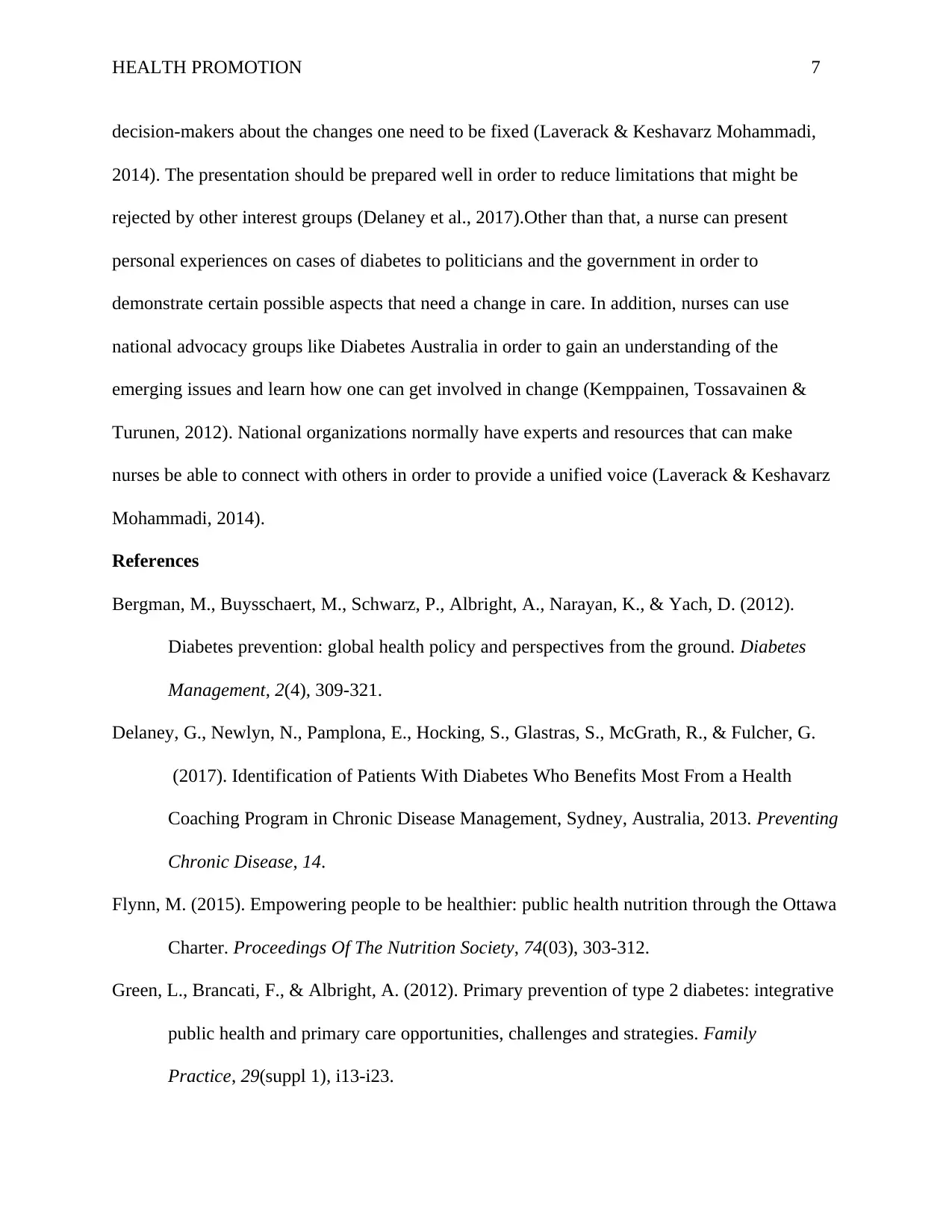
HEALTH PROMOTION 7
decision-makers about the changes one need to be fixed (Laverack & Keshavarz Mohammadi,
2014). The presentation should be prepared well in order to reduce limitations that might be
rejected by other interest groups (Delaney et al., 2017).Other than that, a nurse can present
personal experiences on cases of diabetes to politicians and the government in order to
demonstrate certain possible aspects that need a change in care. In addition, nurses can use
national advocacy groups like Diabetes Australia in order to gain an understanding of the
emerging issues and learn how one can get involved in change (Kemppainen, Tossavainen &
Turunen, 2012). National organizations normally have experts and resources that can make
nurses be able to connect with others in order to provide a unified voice (Laverack & Keshavarz
Mohammadi, 2014).
References
Bergman, M., Buysschaert, M., Schwarz, P., Albright, A., Narayan, K., & Yach, D. (2012).
Diabetes prevention: global health policy and perspectives from the ground. Diabetes
Management, 2(4), 309-321.
Delaney, G., Newlyn, N., Pamplona, E., Hocking, S., Glastras, S., McGrath, R., & Fulcher, G.
(2017). Identification of Patients With Diabetes Who Benefits Most From a Health
Coaching Program in Chronic Disease Management, Sydney, Australia, 2013. Preventing
Chronic Disease, 14.
Flynn, M. (2015). Empowering people to be healthier: public health nutrition through the Ottawa
Charter. Proceedings Of The Nutrition Society, 74(03), 303-312.
Green, L., Brancati, F., & Albright, A. (2012). Primary prevention of type 2 diabetes: integrative
public health and primary care opportunities, challenges and strategies. Family
Practice, 29(suppl 1), i13-i23.
decision-makers about the changes one need to be fixed (Laverack & Keshavarz Mohammadi,
2014). The presentation should be prepared well in order to reduce limitations that might be
rejected by other interest groups (Delaney et al., 2017).Other than that, a nurse can present
personal experiences on cases of diabetes to politicians and the government in order to
demonstrate certain possible aspects that need a change in care. In addition, nurses can use
national advocacy groups like Diabetes Australia in order to gain an understanding of the
emerging issues and learn how one can get involved in change (Kemppainen, Tossavainen &
Turunen, 2012). National organizations normally have experts and resources that can make
nurses be able to connect with others in order to provide a unified voice (Laverack & Keshavarz
Mohammadi, 2014).
References
Bergman, M., Buysschaert, M., Schwarz, P., Albright, A., Narayan, K., & Yach, D. (2012).
Diabetes prevention: global health policy and perspectives from the ground. Diabetes
Management, 2(4), 309-321.
Delaney, G., Newlyn, N., Pamplona, E., Hocking, S., Glastras, S., McGrath, R., & Fulcher, G.
(2017). Identification of Patients With Diabetes Who Benefits Most From a Health
Coaching Program in Chronic Disease Management, Sydney, Australia, 2013. Preventing
Chronic Disease, 14.
Flynn, M. (2015). Empowering people to be healthier: public health nutrition through the Ottawa
Charter. Proceedings Of The Nutrition Society, 74(03), 303-312.
Green, L., Brancati, F., & Albright, A. (2012). Primary prevention of type 2 diabetes: integrative
public health and primary care opportunities, challenges and strategies. Family
Practice, 29(suppl 1), i13-i23.
Paraphrase This Document
Need a fresh take? Get an instant paraphrase of this document with our AI Paraphraser
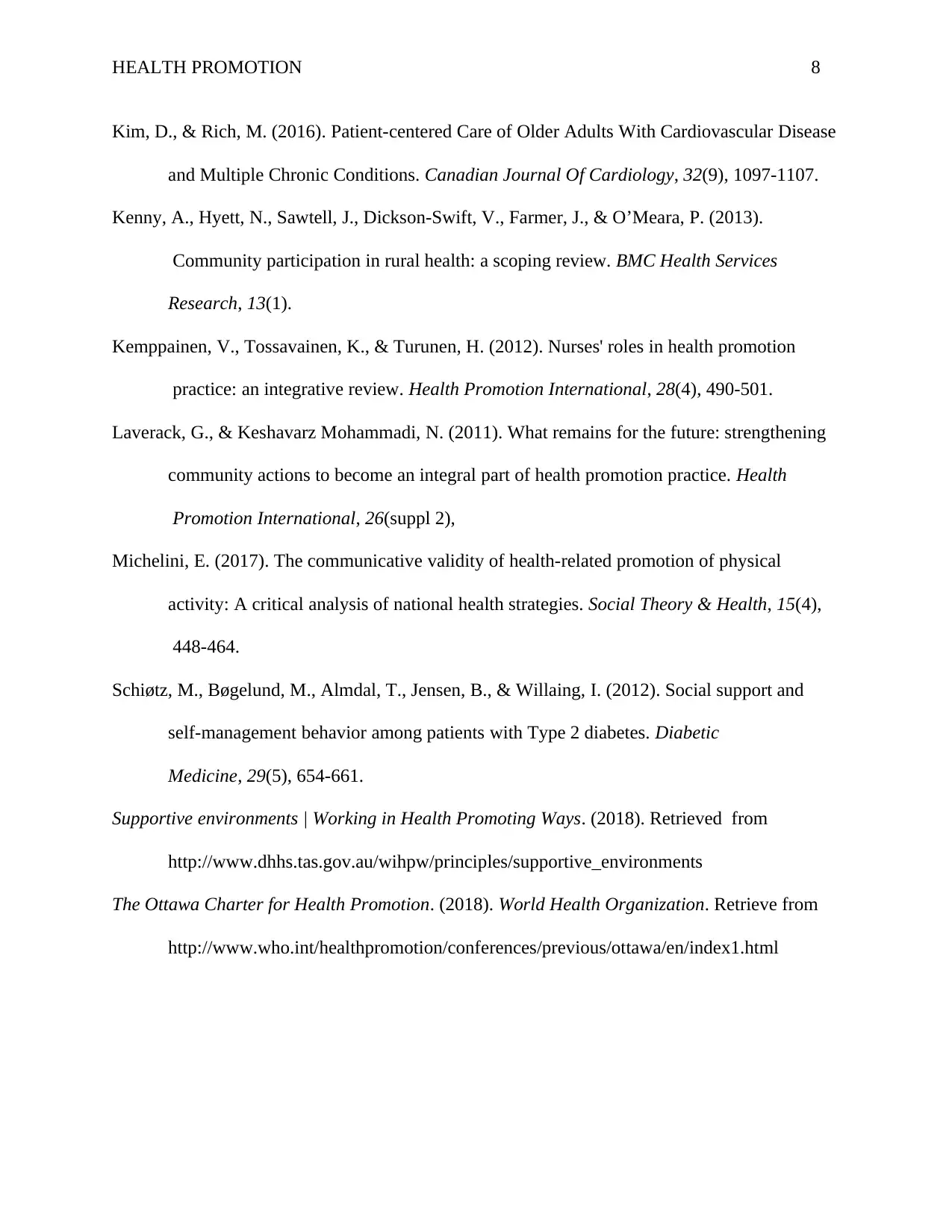
HEALTH PROMOTION 8
Kim, D., & Rich, M. (2016). Patient-centered Care of Older Adults With Cardiovascular Disease
and Multiple Chronic Conditions. Canadian Journal Of Cardiology, 32(9), 1097-1107.
Kenny, A., Hyett, N., Sawtell, J., Dickson-Swift, V., Farmer, J., & O’Meara, P. (2013).
Community participation in rural health: a scoping review. BMC Health Services
Research, 13(1).
Kemppainen, V., Tossavainen, K., & Turunen, H. (2012). Nurses' roles in health promotion
practice: an integrative review. Health Promotion International, 28(4), 490-501.
Laverack, G., & Keshavarz Mohammadi, N. (2011). What remains for the future: strengthening
community actions to become an integral part of health promotion practice. Health
Promotion International, 26(suppl 2),
Michelini, E. (2017). The communicative validity of health-related promotion of physical
activity: A critical analysis of national health strategies. Social Theory & Health, 15(4),
448-464.
Schiøtz, M., Bøgelund, M., Almdal, T., Jensen, B., & Willaing, I. (2012). Social support and
self-management behavior among patients with Type 2 diabetes. Diabetic
Medicine, 29(5), 654-661.
Supportive environments | Working in Health Promoting Ways. (2018). Retrieved from
http://www.dhhs.tas.gov.au/wihpw/principles/supportive_environments
The Ottawa Charter for Health Promotion. (2018). World Health Organization. Retrieve from
http://www.who.int/healthpromotion/conferences/previous/ottawa/en/index1.html
Kim, D., & Rich, M. (2016). Patient-centered Care of Older Adults With Cardiovascular Disease
and Multiple Chronic Conditions. Canadian Journal Of Cardiology, 32(9), 1097-1107.
Kenny, A., Hyett, N., Sawtell, J., Dickson-Swift, V., Farmer, J., & O’Meara, P. (2013).
Community participation in rural health: a scoping review. BMC Health Services
Research, 13(1).
Kemppainen, V., Tossavainen, K., & Turunen, H. (2012). Nurses' roles in health promotion
practice: an integrative review. Health Promotion International, 28(4), 490-501.
Laverack, G., & Keshavarz Mohammadi, N. (2011). What remains for the future: strengthening
community actions to become an integral part of health promotion practice. Health
Promotion International, 26(suppl 2),
Michelini, E. (2017). The communicative validity of health-related promotion of physical
activity: A critical analysis of national health strategies. Social Theory & Health, 15(4),
448-464.
Schiøtz, M., Bøgelund, M., Almdal, T., Jensen, B., & Willaing, I. (2012). Social support and
self-management behavior among patients with Type 2 diabetes. Diabetic
Medicine, 29(5), 654-661.
Supportive environments | Working in Health Promoting Ways. (2018). Retrieved from
http://www.dhhs.tas.gov.au/wihpw/principles/supportive_environments
The Ottawa Charter for Health Promotion. (2018). World Health Organization. Retrieve from
http://www.who.int/healthpromotion/conferences/previous/ottawa/en/index1.html
1 out of 8
Related Documents
Your All-in-One AI-Powered Toolkit for Academic Success.
+13062052269
info@desklib.com
Available 24*7 on WhatsApp / Email
![[object Object]](/_next/static/media/star-bottom.7253800d.svg)
Unlock your academic potential
© 2024 | Zucol Services PVT LTD | All rights reserved.





